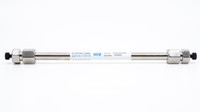Amino Acid Analysis

Concise Separation Columns for Amino Acid Analysis
- Rugged polymeric substrate, stable in pH range of 0 to 14
- High efficiency and resolution
- Reproducibility lot-to-lot and column-to-column
- Available for both physiological samples (Li+ format) and protein hydrolysate samples (Na+ form)
- Post column derivitization detection
Ion-exchange chromatography is a popular technique for the analysis of amino acids because both retention times and quantification are highly reproducible regardless of the sample matrix. This unique matrix insensitivity is important when comparing results from different patients or batches of protein hydrolysate. Amino acids are zwitterions; at low pH, they are positively-charged and are bound to the resin by their attraction to the negatively-charged ion-exchange sites. Almost all the contaminants, i.e. matrix, are eluted at the void. The amino acids are then selectively eluted by increasing the pH and salt concentration with different buffers. With few exceptions, the order of elution follows the isoelectric point of the amino acids, i.e. acidic amino acids first, then neutral and basic. Because the separation and the ensuing post-column reaction of amino acids are devoid of contaminants, amino acid analyses via ion-exchange chromatography are highly reproducible.

